By Alex Trukan
Defending when compact has many advantages, including restricting space for the opposition, more effective pressure on the ball as well as better support and cover around and away from the ball. It can also lead to creating overloads around the ball and eventually winning possession. On the other hand, however, it also carries several trade-offs, which can be exploited by the opposition in possession. One of the main dangers when defending compactly is space away from the ball. When the ball is on one side of the pitch, the opposite one can be defined as the ‘weak side’ or ‘blind side’. Those areas of the pitch are particularly prone to penetration after switching play as the defending team has less players on that side as well as there are more spaces left unmarked. That opens up possibilities to create 1v1 and 1v2 situations, make forward runs without the ball as well as play penetrative passes after a switch.
As soon as the ball is played to one side of the pitch, spaces will open up on the opposite side of it. The shape of the opposition can be slightly affected by positioning of the attacking players. For example, ‘weak side’ winger coming towards the centre of the pitch and full back overlapping will narrow up the opposition back line and possibly stretch the midfield unit. That will create more space in midfield. In order to be able to exploit the opposite side of the pitch, it is important to have ‘chain’ players who will be able to recycle the ball through the centre (if possible) or back.
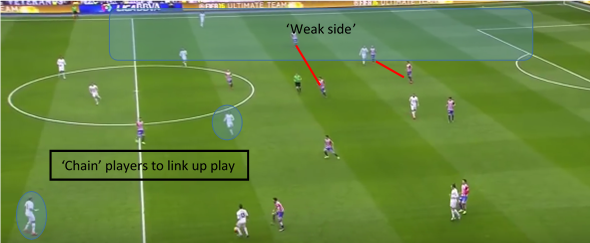
Having no players directly on the weak side of the opposition, will give them licence to narrow up and overload the ball side. In that case the most common way to recycle would be through the back line what will then give players time to position themselves in free spaces on the wings.
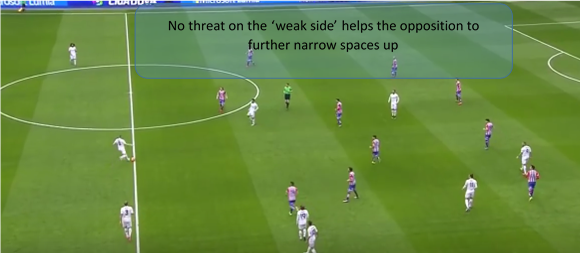
Attacking players (usually winger/full back or striker) on the ‘weak side’ should try and position themselves between the opposition units. Upon switching play that will force the full back rather than wide midfielder to pressurise. That will in turn mean more space in behind the back unit forcing the centre back to come across and support the pressurising full back. In order to make this startegy more effective, it is important to encourage as direct and quick switch as possible. If it is too slow (i.e. by playing the ball backwards), the opposition midfield line will be able to get behind the ball before winger receives it.
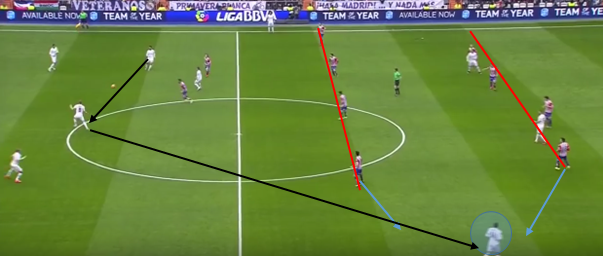
During the process of using ‘chain’ players and trying to exploit the ‘weak side’, it is important to recognise other options if such arise. For example, in reaction to the body position (and possible intentions to play long) of the player on the ball with an option to switch, the opposition back line will often drop back, leaving the spaces for the strikers to receive into feet. If at the same time, gaps between midfielders arise, a pass to the strikers would be a favorable option. As we can see below, left winger’s position forces opposition full back to go wider what then leaves strikers in a 2v3 situation against defenders with spaces in behind.
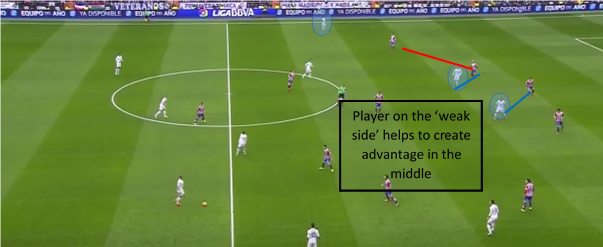
As the ball progresses through the thirds, there will be situations in which the team will not have intention to exploit the ‘weak side’. Primary example of that is when a winger in possession is in an advantageous situation to win a dribbling duel with a full back and cross or deliver the ball directly. In that case, the winger/full back from the opposite side of the pitch would make a run towards the penalty box to finish or to cover by narrowing up in case the ball is lost.
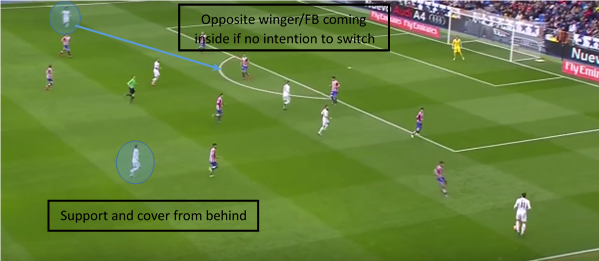
It is important to not force the usage of the opposition’s ‘weak side’ by switching play just for the sake of it but exploit it when other options to play forwards (i.e. as with the strikers described earlier) are not available. From the defensive point of view, having players behind the ball is crucial as in case the ball is lost during the switch (in the middle area), very dangerous counter attacking situation can arise as the opposition has compact block of players around the ball.
By Alex Trukan, Development Coach, Nottingham Forest
@AlexTrukan


